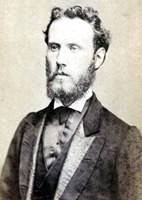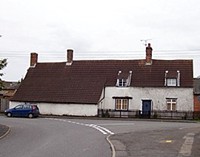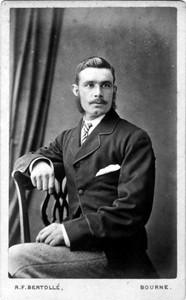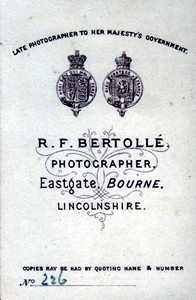|
Richard
Bertolle
1850-1934 |
 |
Photography in Bourne during the 19th century was
largely in the hands of William Redshaw but a lesser known participant was
Richard Bertolle who was active in this field for ten years from around 1880
until 1890.
His family are believed to have originated in Corsica and it is
claimed that one ancestor was an ADC to Napoleon Bonaparte during his many
European campaigns but later members emigrated to England. By 1854, Louis
Bertolle was established in business as a portrait and landscape photographer
at King’s Cross in London, the address on his trade card being given as 4
Offord Road (near the railway bridge), Caledonian Road.
His son, Richard Frederick, was born in 1850 and although details of early life are
vague, it is apparent that he took an interest in his father’s work and became
a proficient photographer himself. There is some evidence that he worked in a
mental institution for a spell before joining the Metropolitan Police Force
where his ability with a camera is believed to have been utilised taking
photographs or “mug shots” of prisoners, a practice then coming into use
as part of a criminal’s records. This theory is borne out by his work in later
years when he described himself in his trade literature as “Late Photographer
to Her Majesty’s Government”.
Bertolle was tall and handsome and in 1873, while carrying out an
investigation in the King’s Cross area, he went into a shop to inquire whether
a certain criminal had been seen in the area and spoke to one of the
assistants, Susannah (Sue) Heffield. She and her cousin, Selina Drakard, had
moved to the capital from Bourne with a local family who had opened a shop
selling milk which was sent by rail overnight from their home town in order
that it could be offered fresh to customers the following morning. There was
an immediate attraction between the two, love at first sight, claimed their
relatives, and they were married the following year. She was 18 and he was 23.
They moved in to live with Richard’s family in Offord Road where their
daughter, Florence Maria (Florrie) was born on 5th September 1875. For some
reason, he left the police force and by 1877 was unemployed and his family
were living in one room at Fulham but Sue was again pregnant. The baby, a boy
they called Louis Bertrand, was a sickly child and she was unable to nourish
him, probably because of malnutrition caused by their circumstances and they
sought help from relatives living nearby.
At this time, Bertolle was offered a job as a labourer by Tom Hinson, a
builder, living in Bourne who was married to his wife’s sister, and so they
left London by train to start a new life in Lincolnshire. The baby died soon
after their arrival but rather than take up the offer of labouring, Bertolle
turned again to photography and opened a studio in the front room of a rented
cottage in Coggles Causeway, Eastgate.
 |
 |
|
The cottage in
Coggles Causeway that
Richard Bertolle rented and which became his first studio (left) and the
building today, still in use although the thatched roof has been removed and
several extensions added. |
Business was brisk as townspeople flocked to have their likeness taken, a new
and popular fad during the late 19th century although he also spent some time
capturing landscapes and town views and was always ready with his camera in
times of crisis. He turned out to record the flooding of the South Fen near
Bourne in 1880 when the River Glen burst its banks and thousands of acres of
farmland were under water as well as areas of the town itself and several of
his photographs have survived to illustrate the drastic effects of the
inundation.
As business improved, Bertolle moved to new premises alongside the Bourne Eau in
South Street, a small detached building which he called the Riverside Studio where he was as busy as ever.
He was also active in the social life of the town and, being a talented
musician who played the violin, helped run dancing classes at the Corn Exchange
and a report from the Grantham Journal on Saturday 13th January 1883
gives an account of one such enterprise:
An invitation dance in connection with the
quadrille class took place at the Corn Exchange on the 4th inst., the company
present numbering upwards of sixty. The band was under the leadership of Mr R
F Bertolle and gave great satisfaction. The refreshments were provided by Mrs
Thornton, of the Nag's Head Hotel, in her usual efficient manner. Mr J J Crane
acted as M C and the various arrangements were carried out very successfully
by the committee, Messrs J Derry, F Johnson, E J Mutton, F C Carter and W N
Mee. It is intended to hold another such gathering before the season closes.
But the popularity and the prosperity was not too last and both
eventually waned after Bertolle became the victim of a campaign of gossip that cost him many of his
customers.
A well-known lady in the town had gone to his studio to be photographed and
while preparing to pose for the camera she asked to have a bible in her hand.
Bertolle handed her the nearest book available which happened to be a
dictionary and the photograph was taken without her realising the mistake but
he later related the tale to his friends and soon it was all over town. The
effect was almost immediate and his custom dried up.
Bertolle decided that he had no choice but to move and despite his wife’s
reluctance to leave Bourne, he set up in business at March in Cambridgeshire
where he rented a house with an adjoining studio in Broad Street. In 1900, his
daughter, Florrie, married William Wild, eldest son of a wealthy local farming
family and they had three children. But in 1911, she was widowed after he was
drowned in the River Nene. His family disowned her and refused any financial
support and so Bertolle became the breadwinner for them all. Anxious to make
more money, he moved to Peterborough where he took on a newsagent’s and
tobacconist’s shop but when the Great War of 1914-18 broke out, Florrie went
to London to work in a munitions factory.
The shop did not do well and Bertolle and his wife went to live in Lancaster
Gardens, Ealing, where their fortunes changed when Florrie’s father-in-law
died, leaving her son Louis a major benefactor in his estate. By 1930, the
family had moved to a large house in St Kilda Road where Bertolle became ill
and was moved to an infirmary at Isleworth where he died in November 1934,
aged 84, and was buried at Sheen. His wife, Sue, died in the West Middlesex
Hospital in July 1935, aged 79. Florrie died at Hayes in August 1951, aged 75,
and Louis eventually married and bought an estate at Fleet in Hampshire.
Richard Bertolle’s Riverside Studio was eventually taken over by another
Bourne photographer, Ashby Swift, only to be demolished when a tree fell on it
in 1920. Apart from family portraits, few of Bertolle’s photographs have survived although previously
unknown views of Bourne do occasionally turn up.
|
 |
 |
|
A carte de visit of a young man produced by
Richard Bertolle at his studio in Eastgate, circa 1880. |
NOTE: I am indebted to Tony
Bedwell for the biographical details of Richard Bertolle’s life
from his history of the Heffield family and to Janet Heffield and Maureen
Tullett for the family photographs.

Go to:
Main Index Villages
Index
|


